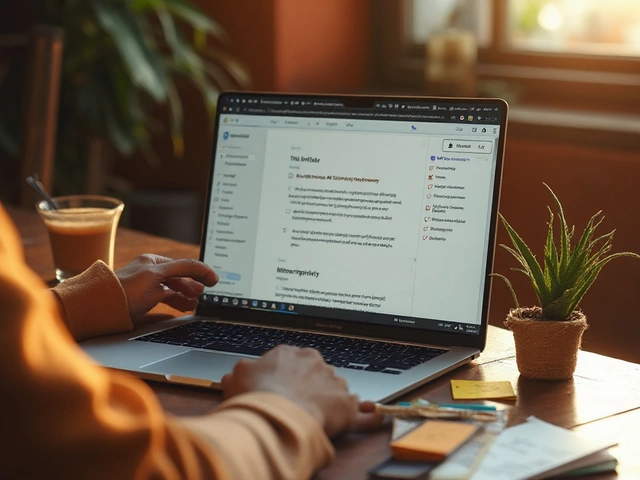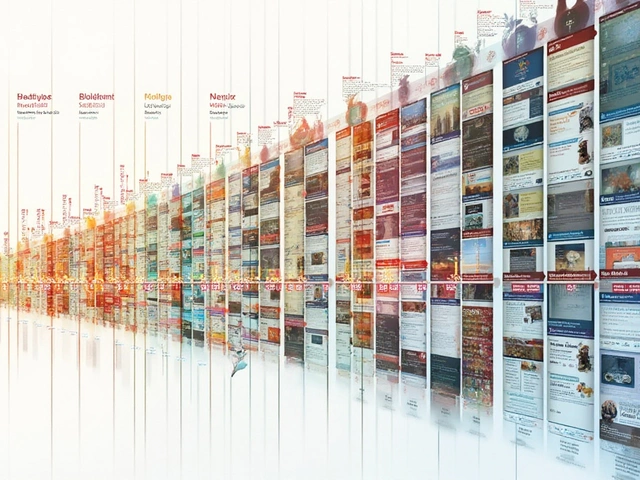If you think earning $1000 from blogging sounds like some internet fairy tale, you’re not alone. But here’s the twist—folks are actually hitting that mark, and a good chunk of them started on free blogging sites like Blogger, WordPress.com, or even Medium. Sure, it’s not quick cash and it won’t happen by writing random posts about your lunch, but the path is way more doable than most people think.
Here’s the catch: free blogs do have their limits. You won’t get all the bells and whistles of self-hosted sites, but you also don’t have upfront costs. What you do get is a chance to build an audience, test what works, and start learning the ropes—without taking out your wallet. That’s a solid win for beginners (and anyone who likes playing it safe).
Let’s break down what actually works on these platforms, where the money comes from, and what mistakes rookies make. You’d be surprised how much can actually happen when you know the shortcuts and don’t fall for the common traps. Ready to see how real people are getting paid just by hitting ‘publish’?
- How Free Blogging Sites Actually Work
- The Truth About Making Money on Free Platforms
- Monetization Tricks That Actually Pay Off
- Common Pitfalls (and How to Dodge Them)
- Real Stories: Who’s Cashing Out—and How
How Free Blogging Sites Actually Work
Free blogging sites are the training ground for a lot of first-time bloggers. Think of places like blogging platforms such as WordPress.com, Blogger, and Medium. When you sign up, you get a basic website space—no credit card needed. You choose a theme, start writing, and your posts go live on the web.
Most of these platforms offer easy-to-use editors, so you don’t need coding skills. You pick your blog name (like mycoolblog.wordpress.com), fill in some profile info, and you’re good to go. The downside? Your control is limited. You usually can’t mess with advanced design or add every plugin you see on fancy paid sites. Plus, free plans stick their branding in your URL and sometimes display their ads, not yours.
Here’s what you typically get with free blogging sites:
- Basic design themes (a few to pick from, not tons)
- Limited storage space (better for text, tight for lots of images or videos)
- Easy sharing options for social media
- Some stats on who’s visiting
Where people get caught off guard is with monetization. Some free sites block things like Google AdSense, affiliate links, or custom ads, while others are more open. The rules change between platforms, so always check before you count on making money.
Just to make it clear, take a look at what the top free blogging sites are offering (as of early 2025):
| Platform | Custom Domain Allowed? | Supports Monetization? | Storage Limit |
|---|---|---|---|
| WordPress.com (Free Plan) | No | No (unless you upgrade) | 1 GB |
| Blogger | Yes (with setup) | Yes (Google AdSense supported) | Unlimited |
| Medium | No | Yes (Medium Partner Program) | Unlimited |
You don’t have to pay for hosting, and setup time is minimal. Stick to what’s allowed, and you can start sharing your ideas or reviews immediately. If you eventually want to get more serious—custom domains, your own ads, deeper tracking—you can always upgrade. For now, though, free sites get you in the game with zero cash down.
The Truth About Making Money on Free Platforms
Let’s be real: earning real money from blogging on free websites isn’t easy, but it’s far from impossible. Free platforms put a ceiling on some things—like custom branding or ad networks—but you can still earn cash if you play your cards right. Most free sites like Blogger, WordPress.com, and Medium let you publish posts for free, but each comes with its own set of rules and limits on how you can make money.
For example, Blogger (owned by Google) lets users connect to AdSense and display ads directly. If your blog starts pulling in steady traffic—think at least a few thousand eyes every month—then those ad clicks can add up. WordPress.com is a bit trickier; you’ll need to sign up for their special plans to run ads, but you can still push affiliate links, sponsored content, or use those posts as a side-hustle portfolio that attracts paid gigs.
Medium, meanwhile, gives you a different model: pays based on read time if you’re part of their Partner Program. Some people report earning hundreds a month with just a handful of viral reads, but most see much less unless they publish consistently and hit topics readers care about.
Here’s what separates earners from dreamers:
- High-traffic topics bring more clicks and reads—think how-to guides, reviews, money tips, or trending debates.
- Regular posting keeps you on the radar of both algorithms and human readers.
- Networking pays—collaborate or comment on blogs with bigger followings.
- Smart use of affiliate links and honest reviews can bring in cash, even if you can’t run direct ads.
The biggest myth? That you need a self-hosted, fancy site to get paid. Loads of creators break $1000 by stacking small payments from ads, affiliate deals, and guest posts, even when starting from a free blog. It does take hustle, but if you stick to valuable topics and learn how to funnel traffic, free isn’t a deal breaker—it’s just where you start.

Monetization Tricks That Actually Pay Off
Most people think ads are the only way to make cash on a free blog, but there’s way more to it. You just need to know what pays and what’s a total waste of your time. On free blogging sites like WordPress.com, Blogger, and Medium, certain tricks work way better than others, especially if your goal is to actually make money.
Start with affiliate links. You don’t need to sell anything yourself — instead, connect your readers with stuff you actually use (or like), then pocket a small commission if they buy. Amazon Associates is popular because it's easy, but even a single sale a day adds up over a month.
Sponsored content is another solid trick. Once your blog gets some traction and steady views, brands might approach you, or you can pitch them directly. It’s not uncommon for small blogs to get between $50-$250 for a single sponsored post, as long as it fits the audience. Tip: Start with smaller brands since the big ones usually want higher traffic numbers.
Email newsletters are a game changer. Use your blog to build an email list (Mailchimp’s free plan is good for newbies), and drop the occasional promo or product link. Even if you have just a few hundred subscribers, a good email pitch can get more clicks than your blog ever does.
Don’t forget digital products. Ebooks, quick courses, simple downloads (think templates or checklists) work well if your audience trusts you. Google Drive works if you can't sell directly on the blog. Just drop a buy link in your post and deliver by email.
| Monetization Method | Possible Earnings Per Month* | What You Need |
|---|---|---|
| Affiliate Marketing | $50 - $400 | Relevant links, trust, steady traffic |
| Sponsored Posts | $50 - $500 | Brands, niche content, good pitch |
| Email Newsletters | $30 - $350 | Subscriber list, promo offers |
| Digital Products | $20 - $600 | Quality downloadables, loyal readers |
*Earnings depend on traffic, audience trust, and how hard you hustle. Some bloggers see much less, a few pull off way more.
If you want ads, WordPress.com lets you use their WordAds if you’re on a paid plan, but Blogger and Medium still show their own ads even on free accounts. So you’ll only see tiny cents until your traffic jumps to the thousands per month. Most bloggers agree that you shouldn’t rely on ads unless you’re already popular.
If you combine two or three of these tricks—even in a small way—you’ll see those earnings inch toward $1000 a whole lot faster than if you just wait for ad dollars to stack up. Always track your results, try new things, and stick with what works for your readers.
Common Pitfalls (and How to Dodge Them)
Most new bloggers jump in hoping for big bucks, but they stumble into the same traps. If you want to actually earn from blogging on free sites, you’ve got to sidestep a few classic mistakes.
First, the biggest blunder: writing random topics with no target. People land on your blog for a reason. If your posts bounce between personal rants, tech tips, and pet stories, you’ll never attract loyal readers or advertisers. Stick to a niche—a focused topic—so your audience knows what to expect, and brands see you as an expert.
Another pitfall is ignoring SEO. Free blogging sites don’t always give you full control, but basic search engine optimization still counts. Stuff like using the right keywords in your title, headers, and intro matters. Skip the keyword stuffing, though—Google isn’t fooled by that trick anymore.
Monetization on free platforms has limits. Blogger lets you use AdSense, but WordPress.com has tight rules on outside ads unless you’re paying for upgrades. If you don’t read the rules and just slap on any affiliate links or banners, you might get your content pulled—or your blog deleted.
Don’t forget about copyright, either. Grabbing random images from Google for your blog can get you takedown notices. Stick with your own photos or use legit free resources like Unsplash or Pixabay.
- Stay consistent—set a posting schedule and stick to it.
- Focus on one main topic to build trust and attract a steady following.
- Double-check platform policies before trying any new monetization method.
- Learn some basic SEO—like using clear titles and internal links—to rank better.
- Build a simple email list right from the start, even if you’re just using a Google Form.
Dodging these mistakes puts you way ahead of most bloggers who give up before seeing a dime. The competition is tough, but it’s not random luck. A little extra effort and some basic know-how keep your blog in the game and actually earning.

Real Stories: Who’s Cashing Out—and How
Here’s the proof—real people are actually earning serious cash on free blogging sites. Not everyone goes viral overnight, but there are solid examples showing it’s possible to pull in $1000 or more, with some even turning their side-hustle into a steady income stream.
Check out Harsh Agrawal. He started blogging on Blogger (a free platform) and made his first $1000 completely without spending a dime on hosting. By reviewing tech gadgets and sharing blogging tips, he attracted enough readers to start monetizing with Google AdSense and affiliate links. His story isn’t just a one-off either.
Or look at Elsie Larson and Emma Chapman from A Beautiful Mess. They kicked off on WordPress.com, shared recipes and DIY projects, and used display ads and partnerships to cash out their first $1000 after a few months of consistent posting. Their blog eventually moved to paid hosting, but all the groundwork—and money—started on free platforms.
Medium’s Partner Program is another way people are collecting payouts. In 2023, nearly 8,000 Medium writers made at least $100 from their articles, and roughly 200 pulled in over $1,000 in a single month. Some, like Sinem Guven, wrote targeted guides and personal stories that regularly landed her monthly earnings of $1,500–$2,000. Her strategy? Posting valuable content and mastering headlines that make readers click.
Here’s a quick breakdown with real numbers from free blogging platforms:
| Platform | User | Payout Method | Time to $1000 |
|---|---|---|---|
| Blogger | Harsh Agrawal | AdSense, Affiliate Links | ~6 months |
| WordPress.com | Elsie & Emma | Ads, Partnerships | ~4 months |
| Medium | Sinem Guven | Medium Partner Program | 2–3 months |
What do these folks have in common? They all picked a focus, delivered consistent posts, and didn’t waste time waiting for some magic moment. Instead, they used every free tool the platform gave them—basic analytics, community forums, and social shares. They also explored small money streams first (like simple ads or affiliate links) before chasing the bigger payouts.
The bottom line: earning $1000 from blogging on free sites is 100% possible. It’s not about luck—it’s about knowing the game, sticking to a plan, and hustling smarter, not just harder.






Written by Arjun Mitra
I am an IT consultant with a keen interest in writing about the evolution of websites and blogs in India. My focus is on how digital spaces are reshaping content creation and consumption. I aim to provide insights and strategies for those looking to thrive in the digital landscape.
All posts: Arjun Mitra